Inside: the complete guide to acrylic mediums you need to know to make amazing mixed media and craft projects
This post includes affiliate links. When you click and purchase from these links we may get a commission from the seller. The cool thing is, this doesn't cost you any extra money!
When I made my first mixed media project it was a mess! I didn't prime my page with gesso, I used glue to attach paper pieces to the canvas and I didn't seal my stamping with gel medium so I ended up with a blob of mud. It was so frustrating! Until a good friend of mine showed me a few materials that changed the way I did all my mixed media, art journaling and even craft projects.
These materials were ACRYLIC MEDIUMS
Sounds scary right? You probably ask yourselves "what are acrylic mediums and how do I use them?" Well... I'm here to help!
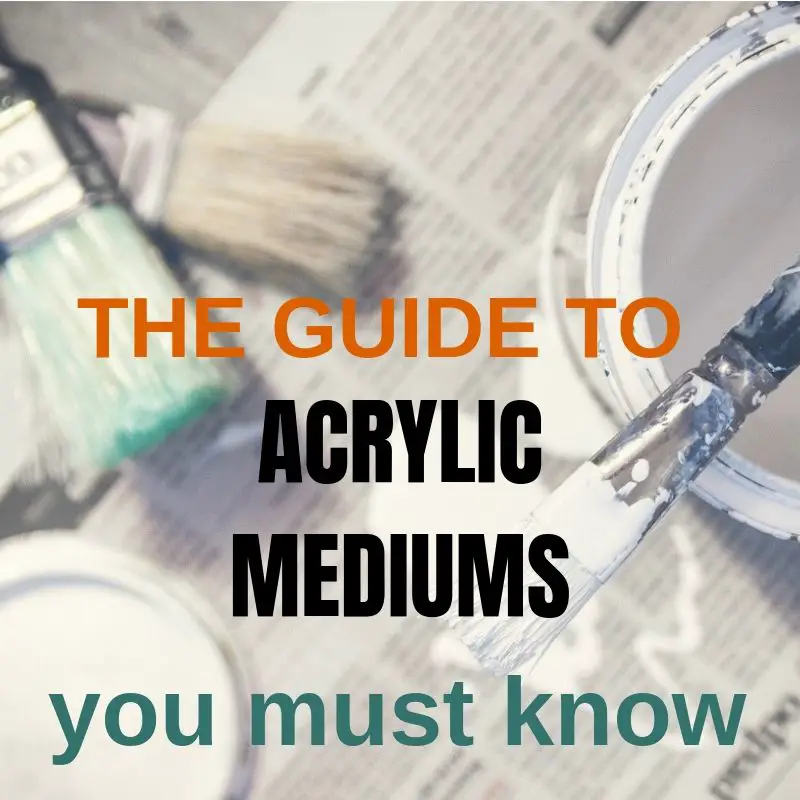
WHAT ARE ACRYLIC MEDIUMS
Acrylic mediums are substances that are added or combined with acrylic paints to change one or more of its properties. Some acrylic mediums are used in addition to acrylic paints and not necessarily with them.
In order to make things clear let's go over the different acrylic mediums in the order you'll use them in a project
PREP ACRYLIC MEDIUMS
Surface preparation mediums are used to seal, prime and add tooth (for color adhesion) to all surfaces such as canvas, wood, paper and metal.

GESSO
The most commonly known and used medium is gesso. Gesso is very similar to white acrylic paint, only thinner. It dries hard, making the surface more stiff. Gesso prepares (or "primes") the surface for painting, making the surface slightly textured and ready to accept acrylic paint. Without gesso, the paint would soak into the weave of the canvas or paper. The beauty of gesso is that you can apply it to nearly any surface, and then you can paint on that surface with acrylic paint. It comes in different viscosity from heavy gesso that has the ability to hold sculptural shape to thin gesso that is a gentle primer for fine art work. Gesso comes in white, clear or black.
WHEN TO USE IT
- When you want to add paints, sprays or other liquid mediums to a project it's best to prime the surface with gesso. Usually canvases are already primed with gesso so you can start painting immediately.
- If you need to paint or spray on metal or other surface or material that can't be painted with acrylic based paints you need to cover that material with gesso to prime it for the paint
After getting familiar with the acrylic mediums you need check out this detailed FREE printable lists showing all the materials you use for art journaling, mixed media and other arts and crafts. Materials like ink, pastels, colored pencils and more. This table lists all the materials' properties and what you need to notice when working with them.
Download this useful FREE list for future reference and guidance for any material you'll use.
ACRYLIC MEDIUMS TO USE WITH PAINT
There are several different types of products you would use in addition to the paint itself: fluid mediums, gel mediums, additives, and texture
gels. Don't worry! You don't need all of them, I just listed them so you'll be familiar with the different materials out there.
In general these mediums are mixed with paint to achieve different results and effects and keep the adhesive qualities of the paint. When it comes to thinning acrylics, the rule is to not mix acrylic paint with more than 50 percent water. Any more than this and the paint may loose its adhesive qualities and peel off at some stage, or lift when you paint over it. When you mix the paint with acrylic medium the paint keeps its adhesive qualities because the mediums have acrylic resin in them that acts as the glue that makes the paint stick to the surface.
FLUID MEDIUMS
Fluid or pouring medium is an additive used to improve paints. By “improve,” we mean that the pouring medium makes acrylic paints pour more smoothly and improves their consistency. It acts as both a diluting agent and a binder. Pouring mediums give us smoother flow and help paints with a mix of colors act more uniformly. They also improve the overall integrity of your paints, so that they dry and finish without cracking, separating, or fading.
WHEN TO USE IT
- When you have a very thick acrylic paint and you need to dilute it
- If the paint is a little dry and you want to bring it back to life
GLAZE ACRYLIC MEDIUMS
Acrylic glazes are the secret ingredient that bring photo realist paintings to life. A glaze is basically a thin layer of paint that is very translucent, allowing some of the color underneath to show through. The glaze subtly transforms the color of what is beneath. This is a popular material among painting artist and less used in mixed media and art journaling.
Extender is basically made with a water soluble Polypropylene Glycol. It is a colorless and innocuous liquid found in hand lotions, soap and hundreds of other products safely used by humans. In a nutshell, when it is mixed with paint, it allows it to dry slower, stay open or workable for a longer period of time.
WHEN TO USE IT
- When you work in a very hot and/or dry environment where the paint dries fast
- If you want to blend many colors
GEL MEDIUM
Gel Medium is essentially a binder without pigment. On the opposite end of the spectrum from Fluid Mediums, gel mediums add body to thinner paint as well as extending color volume and adding transparency. There are three basic types of Gel Mediums–Soft, Regular, and Heavy. You'll often see that gel medium is also called matte medium.
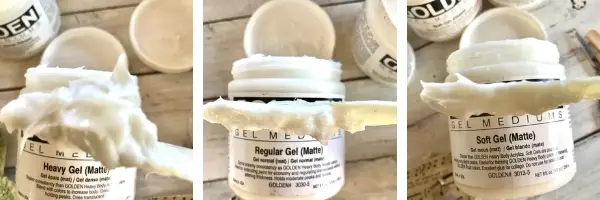
SOFT GEL
Paper and Mixed Media artists most often use soft gel as an adhesive because its smooth consistency allows them to manipulate, move, and place collage materials or ephemera. It is not as ‘wet’ as other adhesives, so it allows the paper to settle more quickly with less curling.
WHEN TO USE IT
- As glue for paper collage and covering surfaces
- Sealing a layer of paint, ink or spray to prevent them from smearing
- For transferring techniques. Basically, an image is printed and cut out. The area where the Transfer is to be set is coated, then the image is placed face down and burnished with a bone folder or back of a spoon. Gently lift a corner of the image and peel off. Check out this art journal page with a photo transfer video tutorial
REGULAR GEL MEDIUM
Regular Gel extends paint open time (stays wet longer) while maintaining its consistency. It's basically like a paint extender.
HEAVY GEL MEDIUM
Heavy Gel increases the body of paint and has the ability to hold peaks. There are also Extra Heavy Gels which bring more texture building capabilities.
WHEN TO USE IT
- When you want thicker paint for more texture
- If you need to attach heavy items like metal to a project heavy gel medium will hold them better than any glue
MODELING PASTE
Modeling paste, sometimes called molding paste, is a thick substance filled with hard solids that produces a textured effect when applied to canvas or other surfaces. It can be mixed with acrylic paint while still wet to create a thick paint, or it is possible to add color over the top of dry paste too. It is matte, opaque and dries to a very hard
Other texture pastes come in a gel form:
- White Opaque Flakes: a heavy, coarse gel containing irregular sized and shaped white opaque flakes. Has a similar effect of snow flakes or coconut flakes.
- Glass Beads: a medium body gel that contains clear round plastic beads and dries to a semi-gloss surface. Perfect for creating a “bubbly” but smooth texture that can be dramatic when mixed with color.
WHEN TO USE IT
- To add texture to paintings and mixed media projects. Apply it with a palette knife or stencils. After applying on the surface you can make patterns with a toothpick, brush or other tools
- When you want to create a colored raised texture by mixing it with acrylic paints
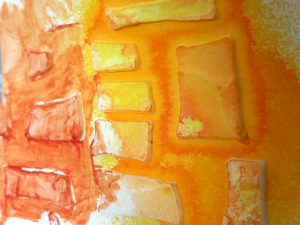
OTHER ACRYLIC MEDIUMS
FABRIC MEDIUM
Enhances blending, workability, and adhesion of acrylic colors for painting directly on fabric or un-primed canvas. No heat setting required. Simply mixed it with acrylic paint to easily paint on any fabric.
IRIDESCENT MEDIUM
Adds richness to acrylic colors by creating a metallic effect. Dries translucent and will not oxidize. Can add shimmer or sparkle to a picture even in the smallest amount.
I hope this acrylic mediums guide helped unravel the questions and mystery around the subject of what acrylic mediums are, why you need them and when to use them. Leave me a comment telling me if you found it helpful or if you have any questions.
Save it for later - PIN IT!
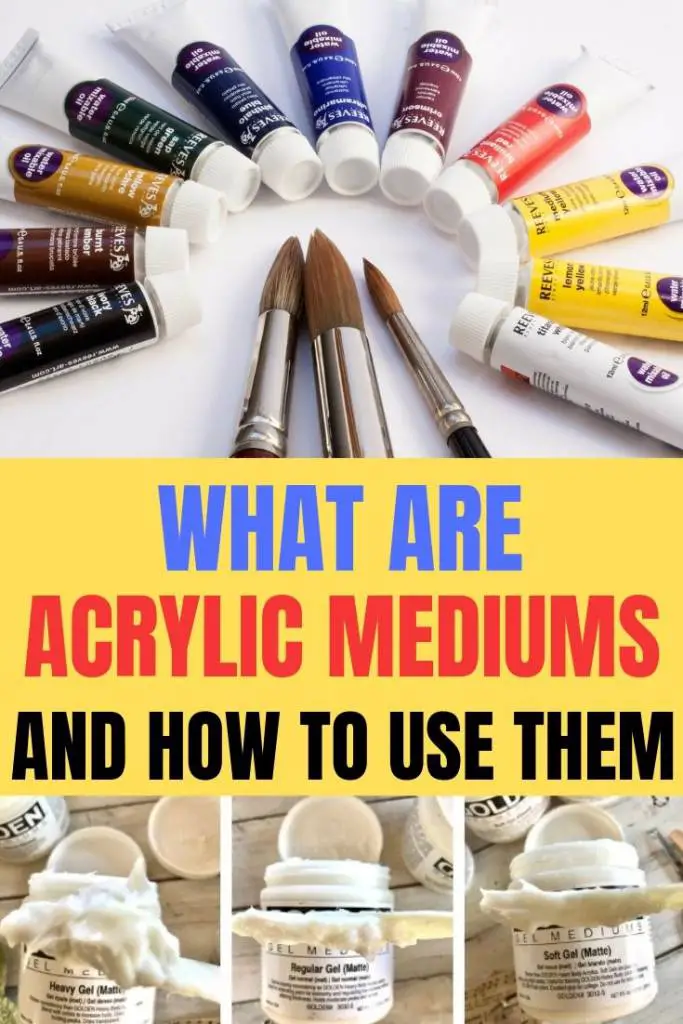
Have fun creating!
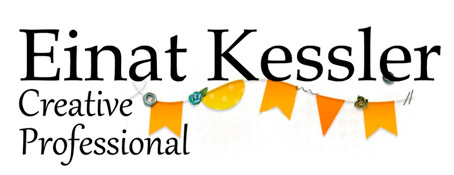




18 comments on “AWESOME GUIDE TO ACRYLIC MEDIUMS YOU NEED TO KNOW”
I am new to all this l have been putting floetral with tubed paint to thin it to do pour painting and l have got gesso but never used it and silicone never used it .all l want is some direction how to use it.thank you.
You use gesso as a base for canvases, wood, paper etc for the paints and other mediums to “stick” better to the surface
I’m considering a project using modeling paste to create a “meringue” effect. If I apply cling film to the top of the paste, let it dry somewhat, then lift the cling wrap, it should work. Problem: I don’t know how long modeling paste takes to dry, so I don’t know how long to leave the cling film in place. Any thoughts??? Thanks for any help you can offer.
The drying time of modeling paste depends on the brand and the weather so it’s difficult to say. You will have to experimnt with a little paste and see.
If I wanted to add some real leaves to a painting, after drying them and spraying them with a krylon protectant, would I use a soft gel to adhere them?
(and thank you for your wonderful explanations!)
Yes!
Hello.
Just wanting to know, if I’m adding material and want parts of it to be painted on with oils. Must I seal the whole canvas (with material on it) before I paint.
Thankyou for all your help:)
It is always recommended to seal the canvas especially if you’re adding other materials.
I feel I have been trying to piece this information together for years! Thanks for your hard work.
A very interesting article, all the different products are confusing. I bought a container of Glaze Medium, for mixed media work. You said mixed media artists don’t tend to use it, is there any way I can use it mixed media? As a glue for paper for example.
You can use it for glue or to make acrylic paints more transparent
wonderful issues altogether, you simply received a new reader.
What may you suggest in regards to your put up that you just made a
few days ago? Any sure?
Thank you SO much for this wonderful guide! I think we all have questions about the many, many mediums out there!! This is very much appreciated!
You’re welcome!
This is wonderful. I know you put a lot of time and effort into this and I really appreciate you sharing it.
Thank you, Einat!
Thank you Suzie!
Thanks Einat…..a reminder for me….hopefully a great description of all for the newcomers….you do look after us! xx
Thanks Sall